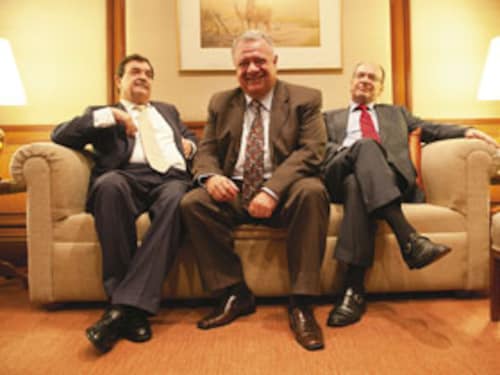Latin America Teams Up
The ambassadors of Peru, Columbia and Chile tell us about integrating their markets and where India features on their map


Peru, Colombia and Chile have, for long, lived in the shadow of Brazil.
The economies of these three Latin American countries, however, have had a great run in recent years, with each country taking steps towards pro-market and pro-business reforms. The most important of these has been integrating their stock markets. They are on schedule to open up borders to free movement of goods and people, even as they struggle with unemployment, trafficking of narcotics and economic inequality.
The three nations are rich in minerals and depend a lot on commodity exports. Many Indian companies have found them to be attractive bases to serve larger North American markets.
Ambassadors Javier Paulinich of Peru, Juan Alfredo Pinto of Colombia and Cristian Barros of Chile were in Mumbai to get Indian investors interested in the Integrated Latin American market, known by its Spanish acronym Mila. The integrated market combines 563 companies and is the second largest in the region after Brazil.
How important is India to your plans?
Cristian Barros (Chile): We are not very well known in this region and most people may not be able to point us out on a map. We are now acting like three countries, maybe with different approaches, but with one spirit. We are trying to open up a free trade agreement with India that will help enhance trade. Negotiations for this have just begun and we hope to conclude them this year.
Javier Paulinich (Peru): Mutual trade between India and Peru is close to $1billion. We are among the top 10 producers of most of the important minerals that India needs. We are clear about opening up the economy to overcome the poverty that many of our people live in. The steps that India takes by way of reforms will give us more opportunities for cooperation. The integration of the stock exchanges will allow more Indians to invest in the Latin American markets. India is turning into a big manufacturing country and we are large exporters of resources.
How has the relationship with Indian companies been so far?
Juan Alfredo Pinto (Colombia): It seems that real economic activity is growing faster than institutional processes in Colombia and India. Dozens of Indian companies such as ONGC Videsh, Hero Honda and IT firms are already present in Colombia. We have to ease the process so that others can follow. One big step forward is our line of questioning: From asking ‘how poor are we?’ we have moved to ‘how much opportunity is there?’
The number of Indian companies doing business in Colombia has increased six-fold in the last three years. But, for me, the real mission is to introduce these relationships in the brains of the politicians. We want to be known not just for the Inca civilisation and for history. You know only Gabriel Garcia Marquez from Colombia. But how long will it be before you start reading the new authors from my country, just as we have started reading Vikram Seth. As of now, reality is moving faster than our leadership.
How has Peru dealt with environmental issues that arise from large scale mining?
Paulinich: We have clear mining laws that involve the whole community. Environmental project evaluation is mandatory even during exploration of minerals. Companies have to share a percentage of the profits with the community. Small villages have benefitted from mining. The community has to approve the agreements. For instance, 70 percent of our population agreed to the free trade agreement with the US. Mining started initially as an extractive business, but gradually there has been value addition and refining. President Garcia has in place laws to manage the balance between exploiting the reserves and protecting the environment.
Each of your countries has a deep income disparity among the population. How do you deal with it?
Pinto: Education is the key. The new hero in the post-ideological world is knowledge. In Latin America, we’ve had all kinds of ideologies in the past 40 years. The new leadership of presidents Santos, Garcia and Pinera has seen a surge in growth.
But growth is not enough people need employment. The quality of growth has to be right. In Colombia, the policy is to increase spending on welfare schemes. But we have found it more useful to give money directly. We have targeted cash subsidies directly to needy families. These are equivalent to 30 percent to 40 percent of the minimum wages.
But the money is given only on certain conditions: One condition is the families have to send their children to school and give them proper meals.
First Published: Jan 17, 2011, 09:53
Subscribe Now